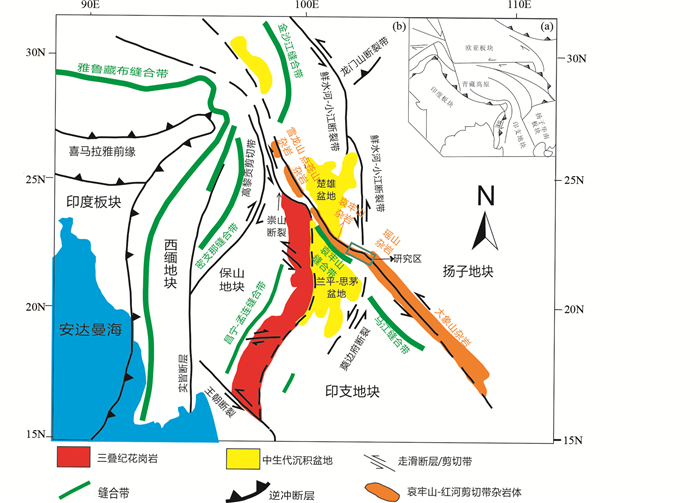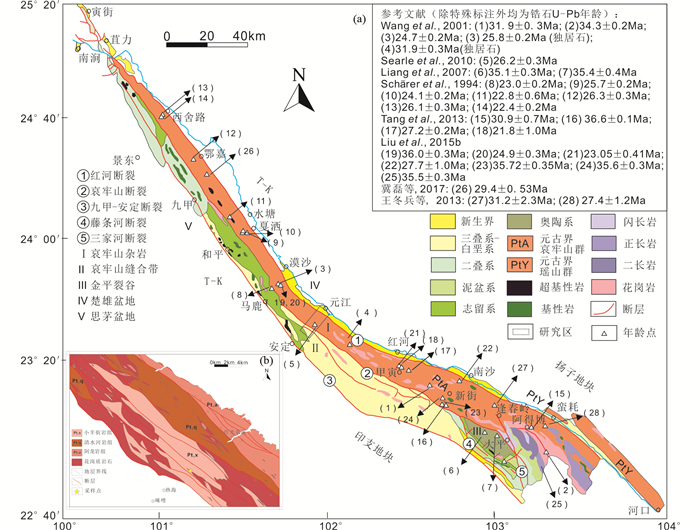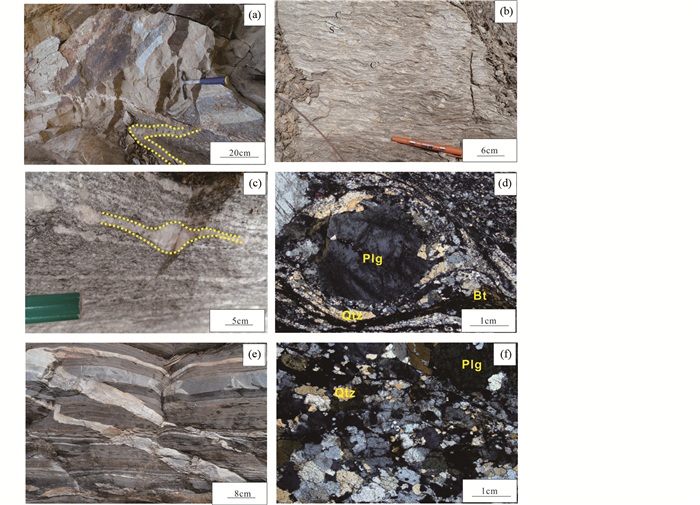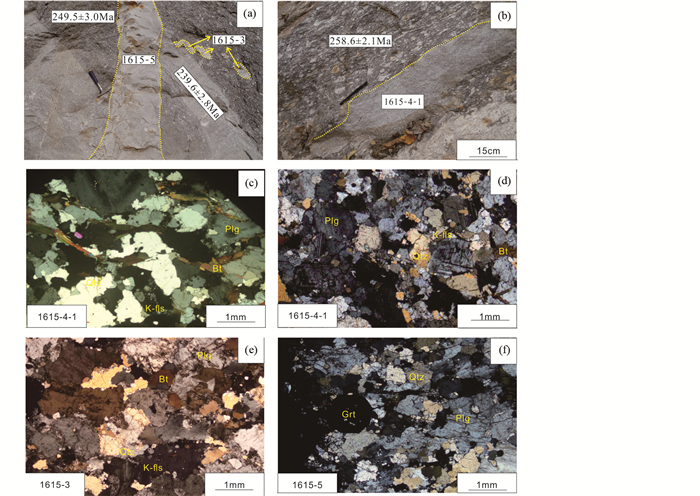2. 中国地质大学地质过程与矿产资源国家重点实验室, 北京 100083
2. State Key Laboratory of Geological Processes and Mineral Resources, China University of Geosciences, Beijing 100083, China
哀牢山-红河剪切带(图 1)是青藏高原东南缘的一条重要线性构造带,其发育调节了印度板块和欧亚板块碰撞引发的印支地块大规模南东向逃逸(Tapponnier et al., 1982, 1986; England and Houseman, 1986; Searle, 2006; Searle et al., 2010; 刘俊来等, 2006; Chen et al., 2015)。剪切带起始与终止时间、剪切过程中岩浆活动,变质事件与成矿作用、区域变形过程中变形的阶段划分及控制因素、不同变形阶段岩石矿物流变特征与变形机制等,是多年来的研究热点(Houseman and England, 1986, 1993; England and Molnar, 1990, 1997; Chung et al., 1997; 杨振宇等, 2001; Gilley et al., 2003; Searle, 2006; 刘俊来等, 2006; Yeh et al., 2008; Searle et al., 2010; Deng et al., 2014, 2017; Chen et al., 2015; 史鹏亮等, 2015; Deng and Wang, 2016; Zhang et al., 2017)。

|
图 1 哀牢山剪切带及其邻区大地构造简图 (据Leloup et al., 1995; 刘俊来等, 2006) Fig. 1 Skecth of tectonic map of Ailao Shan-Red River shear zone and adjacent area (modified after Leloup et al., 1995; Liu et al., 2006) |
沿着哀牢山-红河剪切带存在大量不同时期的岩浆活动,包括新元古代岩浆活动(Cai et al., 2014; 戚学祥等, 2010; Qi et al., 2014, 2016; Chen et al., 2017a)、二叠纪-三叠纪花岗岩(Jian et al., 2009a, b; Fan et al., 2010; 刘俊来等, 2006; 刘翠等, 2011; 王舫等, 2011; Lai et al., 2014a, b; Liu et al., 2014; 冀磊等, 2017; Wu et al., 2017a)、以及大量新生代花岗岩(Schärer et al., 1990, 1994; Gilley et al., 2003; Sassier et al., 2009; Cao et al., 2011a, b; Tang et al., 2013; Liu et al., 2015b; Chen et al., 2017b)。它们多数遭受了不同程度的糜棱岩化作用的改造(Cao et al., 2011a, b; Tang et al., 2013; Liu et al., 2015b; Chen et al., 2016)。综合具有不同变形特点的花岗质岩石结晶年龄、岩石宏观、微观变形特点与组构特征、以及大量热年代学研究结果(见图 2a),目前基本限定了哀牢山-红河剪切带剪切变形时间在约31~21Ma(Leloup and Kienast, 1993; Leloup et al., 1995, 2001; Nam et al., 1998; Jolivet et al., 2001; Yeh et al., 2008; Anczkiewicz et al., 2007; Searle et al., 2010; Cao et al., 2011a; Liu et al., 2012; Tang et al., 2013; Chen et al., 2017b; Wu et al., 2017b)。然而,最近的详细研究揭示该剪切带剪切作用具有显著的阶段性,即早阶段的纯剪剪切为主的一般剪切变形和晚阶段以单剪剪切变形为主的一般剪切变形(Liu et al., 2012; Wu et al., 2017b),但是, 迄今对于变形体制转换时间仍没有明确的限定。

|
图 2 哀牢山杂岩构造简图(a,据Liu et al., 2012, 2015b)和元江-墨江地质简图(b,据云南地质矿产勘查开发局区域地质调查所,1996①修编) Fig. 2 Structural outline of the Ailao Shan complex (a, after Liu et al., 2012, 2015b) and sketch geological map of Yuanjiang-Mojiang (b) |
① 云南地质矿产勘查开发局区域地质调查所. 1996. 1/50000红光农场幅地质图
通过研究不同变形阶段侵位与剪切变形相关联花岗岩脉的侵位时代、变形特点的综合分析是解决上述问题的有效途径之一。本文选取哀牢山-红河剪切带中段元江-墨江剖面中具有不同变形特点的新生代花岗质岩脉为研究对象,基于宏观构造、显微构造与石英c轴组构分析,结合应用岩脉锆石U-Pb定年以期对哀牢山-红河剪切带剪切应变型式的转变提供约束,进而阐明不同阶段剪切变形的区域构造意义。
1 区域地质背景与哀牢山中段构造特点哀牢山-红河剪切带位于青藏高原东南缘,长度大于1000km,宽度达20~30km,向南延伸进入南中国海。沿哀牢山-红河剪切带出露四个变质杂岩体,自北向南依次是雪龙山杂岩、点苍山杂岩、哀牢山杂岩和大象山杂岩(中国境内称瑶山杂岩),它们记载了哀牢山剪切带变形演化的历史。
位于哀牢山-红河剪切带中段的哀牢山杂岩北起云南南涧,其北段走向约290°,在元江咪哩附近发生转向为310°,之后在大平再次转向约290°,并向南经金平延伸进入越南境内范式坂地区。杂岩体平面上呈北西段狭窄,南东段开阔的楔形形态(刘俊来等, 2006),由深变质岩带和浅变质岩带两部分组成。深变质岩带位于东侧,与扬子地块沉积岩系之间以红河断裂分隔;浅变质岩带位于西侧,与毗邻的印支地块间发育九甲-安定断裂(Leloup et al., 1995; 刘俊来等, 2006; Liu et al., 2012)。在哀牢山杂岩体内,深变质岩带与浅变质岩带之间存在明显不连续性,该不连续面曾命名为哀牢山断裂,其两侧具有相似变形特点的岩石具有强烈的变质程度差异。
位于哀牢山杂岩带中段的元江-墨江剖面(图 2b)中,深变质岩带东起元江县红光农场,西止于咪哩-热海附近。深变质带岩石统称哀牢山岩群,自西向东依次划分为小羊街岩组、清水河岩组和阿龙岩组三部分,各岩组之间接触关系为断层接触。总体上看,变质岩系自西向东变质程度逐渐加强,由低角闪岩相逐渐过渡到高角闪岩相(Zhang and Schärer, 1999; 刘翠等, 2011; Liu et al., 2015a),局部零星出现麻粒岩相变质岩(戚学祥等, 2012; Liu et al., 2013, 2015a)。变质程度较高岩石可见部分熔融作用和混合岩化现象。区域变质岩岩石类型包括变质富铝质岩石、镁铁质岩石、变质碳酸盐岩、钙硅酸盐岩等,岩性包括麻粒岩、变粒岩、片麻岩、片岩、大理岩、斜长角闪岩等,特征变质矿物包括石榴石、矽线石、黑云母、斜长石、透辉石、透闪石、橄榄石、白云母等。在深变质杂岩中,由于新生代强烈的剪切变质作用,构造叠加和变质叠加现象明显(如叶理(Sn)被后期糜棱叶理(Sn+1)置换现象),致使深变质带内岩石基本层序消失或难以识别。变质叠加作用主要为退变质作用,一般认为由杂岩体剥露抬升引起(Searle et al., 2010; 戚学祥等, 2012; 冀磊等, 2017)。对特征变质矿物进行变质温压分析认为,哀牢山地区变质峰期温压条件为640~780℃、3.0~8.1kbar(Leloup and Kienast, 1993; Gilley et al., 2003);局部可达850~920℃、9.2~10.4kbar(戚学祥等, 2012),后期退变质条件为500~625℃、3.5~5.2kbar(Leloup and Kienast, 1993; Gilley et al., 2003; 戚学祥等, 2012)。
糜棱岩化作用在哀牢山杂岩带内发育广泛,在杂岩体内有多条糜棱岩带,糜棱岩化发生时间在古-中新世(刘俊来等, 2006; Liu et al., 2010a, 2011)。由于糜棱岩化作用,形成一系列L,L-S构造岩(Cao et al., 2011a, b, 2012; Liu et al., 2012, 2013)。其中的糜棱岩化花岗质岩石原岩时代包括二叠纪-三叠纪和新生代(Liu et al., 2011, 2012; Cao et al., 2012)。前者代表了古特提斯洋盆的闭合(Jian et al., 2009a, b; Fan et al., 2010; 刘翠等, 2011; 王舫等, 2011; Lai et al., 2014a, b; Liu et al., 2014; Wu et al., 2017a;冀磊等, 2017)。由于始新世-渐新世走滑剪切作用改造,不同时期的花岗岩脉出现倾向NE-SW向,倾角中等或较陡(约45°~60°)糜棱叶理和倾伏向SE-NW,倾伏角平缓的线理。岩石中常可见左行指向标志(Tapponnier et al., 1990; Leloup et al., 1995; Liu et al., 2012)。由于新生代花岗岩脉就位之后遭受的剪切改造程度不一致,其就位时间不一,糜棱岩化程度不同。根据花岗岩脉与剪切作用时间关系,可以将花岗岩脉分为剪切前、同剪切和剪切后花岗岩脉。其中,同剪切花岗岩脉又可分为同剪切早期与同剪切晚期花岗岩脉(Searle, 2006; Cao et al., 2011a; 陈小宇等, 2017b)。其中,同剪切淡色花岗岩以及哀牢山杂岩带和浅变质岩带中均有出现的透镜状含角闪石碱性岩脉(Zhang and Schärer, 1999)可以用来限定哀牢山-红河剪切带剪切变形作用的时限。经历糜棱岩化改造的岩脉遭受变形作用后,形成透镜体或褶皱。同剪切早期脉体构成的褶皱两翼平行(图 3a),而同剪切晚期脉体的褶皱往往呈不对称状(Liu et al., 2012)。同时,剪切变形的岩脉常保留有SCC’组构(图 3b)、旋转碎斑系(图 3c)、云母鱼等剪切指向标志,显示左行走滑特点,糜棱岩化作用常导致矿物细粒化现象出现(图 3d)(Searle, 2006; Searle et al., 2010; Tang et al., 2013)。剪切作用之后侵入的花岗岩脉由于没有经历糜棱岩化作用,因此常切穿糜棱叶理,矿物也没有糜棱岩化改造后的细粒化现象(图 3e, f)。

|
图 3 元江-墨江剖面岩石变形构造与显微构造 (a)同剪切早期花岗岩脉褶皱;(b)S-C-C’组构;(c)长石残斑;(d)糜棱岩化过程中矿物细粒化,且同时发生矿物定向;(e、f)剪切期后花岗岩脉宏观、微观特点 Fig. 3 Structural geology along Yuanjiang-Mojiang section (a) folding of early-shearing dykes; (b) S-C-C' fabric; (c) porphyroclastic plagioclase; (d) grain size reduction of mineral grains by milonization and orientation of the grains; (e-f) post-shearing granitic intrusion in macroscale and mesoscale |
在元江-墨江剖面中,脉状印支期花岗岩与新生代花岗岩广泛发育,前者表现为糜棱岩化作用强烈,形成发育的糜棱叶理和拉伸线理。新生代花岗岩脉常常穿切前者,并表现出不一致的变形特点(图 4a, b)。

|
图 4 样品宏观产状与显微构造特点 (a、b)样品野外露头情况;(c、d)同剪切花岗岩脉变形特征;(e、f)剪切晚期花岗岩脉特征 Fig. 4 Mesoscopic and microscopic structures of the granitic dykes (a, b) photos of samples in field; (c, d) characteristics of syn-shearing granitic dykes; (e, f) characteristics of late-shearing granitic dykes |
岩脉ALYJ1615-4-1具有同剪切早期花岗岩脉的宏观和微观特点(图 4b-d)。岩脉沿着围岩的叶理方向延伸,且具有显著的矿物定向排列特征形成叶理,叶理与拉伸线理产状与哀牢山-红河剪切带区域糜棱叶理、拉伸线理一致。显微观察可见黑云母具有一定定向性排列特征。钾长石可见卡式双晶,周边发育有蠕英构造。斜长石呈半自形-他形,可见机械双晶与变形纹现象,双晶纹宽度不一,且在一些颗粒内发生尖灭。石英颗粒呈他形粒状,偶尔可见波状消光现象,属于同剪切花岗岩脉特征。
岩脉ALYJ1615-3为同剪切晚期就位花岗岩脉。宏观露头体现出遭受剪切作用形成褶皱,脉壁宽度较为稳定,形态略有弯曲,并且在侧向上分散为两枝(图 4a)。围岩为强烈糜棱岩化并具有透入性叶理和线理的花岗质糜棱岩,岩脉切穿其糜棱叶理。同时,花岗岩脉末端呈现出肿缩状,表现出微弱变形改造特点。显微观察发现,岩石以保留较明显的花岗结构和构造特点为主。组成矿物多保持原始结晶状态,比如长石呈自形-半自形板柱状,边界较为平直,钾长石可见蠕英构造。石英呈他形粒状,可见波状消光与膨凸重结晶现象,边界呈现出锯齿状、港湾状特点,属于结晶后变形改造的证据(图 4e)。
岩脉ALYJ1615-5为同剪切晚期淡色石榴石白云母花岗岩。露头观察可以发现,岩脉与围岩界线平直,该岩脉切穿前期所有岩脉(图 4a)及这些岩脉中的糜棱叶理构造。矿物颗粒较细,具有花岗结构和块状构造特征。显微观察揭示出,长石粒径较大者呈半自形板柱状,较小者呈他形粒状,钾长石可见蠕英构造。斜长石颗粒部分可见少量机械双晶与变形纹,石英呈他形粒状,可见微弱波状消光现象,石榴石晶形较完整,说明该岩脉也遭受了一定程度的变形作用,但变形程度很弱,代表了该岩脉就位时间在变形晚期到变形结束(图 4f)。
3 技术方法 3.1 LA-ICP-MS锆石测年技术将岩石样品(>5kg)粉碎后,采用重液分选和磁分选技术获得单矿物锆石颗粒样品。锆石分选后,使用双目镜挑选锆石颗粒(约200粒),粘贴在双面胶上,加注环氧树脂固化制作成靶。固化后的锆石靶打磨抛光,磨去约一半厚度,使锆石中心暴露。打磨后的靶在光学显微镜下拍摄透、反射图像,再通过阴极发光技术观察锆石振荡环带,确定适合分析的锆石颗粒。
LA-ICP-MS锆石U-Pb年代学测试在吉林大学东北亚矿产资源评价国土资源部重点实验室完成。激光剥蚀使用德国相干公司(Coherent)COMPExPro型ArF准分子激光器,质谱仪为美国安捷伦公司7500A型四极杆等离子质谱。激光条件为:激光束斑直径32μm,激光能量密度10J/cm2,剥蚀频率8Hz。剥蚀样品前首先采集30s的空白,随后进行30s的样品剥蚀,剥蚀完成后进行2min的样品池冲洗。载气使用高纯度He气,气流量为600mL/min;辅助气为Ar气,气流量为1.15L/min。对于不用同位素的采集时间,204Pb、206Pb、207Pb和208Pb为20ms,232Th、238U为15ms,49Ti为20ms,其余元素为6ms。使用标准锆石91500(1062Ma)作为外标进行同位素比值校正,标准锆石PLE/GJ-1/Qing Hu为监控盲样。元素含量以国际标样NIST610为外标,29Si为内标元素进行计算,NIST612和NIST614为监控盲样。测试分析后的数据使用ICPMSDataCal 10.2软件进行同位素比值及元素含量的计算,具体操作见(Liu et al., 2008, 2010b)。谐和年龄及图像使用Isoplot/Ex(3.0)给出(Ludwig, 2003)。普通铅校正使用Andersen (2002)给出的程序计算。分析数据及锆石U-Pb谐和图给出误差为1σ,表示95%的置信度。
3.2 石英c轴结晶学组构EBSD分析技术石英c轴结晶学组构研究在中国地质大学(北京)地质过程与矿产资源国家重点实验室完成。当扫描电子显微镜入射电子束撞击分析样品满足布拉格衍射条件时,会产生菊池花样。通过分析菊池花样即可对待分析晶体进行研究(曹淑云和刘俊来, 2006)。定向光薄片使用BUEHLER MASTERMET非晶质硅酸胶体抛光液,在BUEHLER Alpha & Beta磨抛机中抛光2h。实验操作分析由Hitachi S-3400N Ⅱ扫描电子显微镜附加的HKL Nordlys电子背散射探头套件(EBSD)和HKL CHANNEL5软件获取、处理数据,工作电压15kV,工作距离18.4mm。标本准备及实验操作具体可见(刘俊来等, 2008)。
4 分析结果 4.1 锆石U-Pb测年结果样品ALYJ1615-4-1的锆石自形程度较好,长宽比3: 1~4: 1,锆石振荡环带清晰,CL图像较亮。选取测试部分为锆石边部。每颗锆石测试1个数据点,测试点共计28个。去除偏离协和线较远、协和度低、或者有混合年龄可能的数据,共有12个数据点在谐和线上或附近(图 5a),这12颗锆石Th含量在568×10-6~3660×10-6之间,U含量在997×10-6~7135×10-6之间,Th/U值在0.47~0.84之间(表 1)。这12颗锆石的206Pb/238U年龄在26.0~28.6Ma之间,加权平均年龄为27.09±0.48Ma(MSWD=2.8),代表花岗岩脉结晶年龄。

|
图 5 锆石U-Pb年龄协和图和锆石阴极发光图像 (a)样品ALYJ1615-4-1;(b)样品ALYJ1615-3;(c)样品ALYJ1615-5 Fig. 5 CL images of zircons and LA-ICP-MS U-Pb concordia diagram |
|
|
表 1 哀牢山杂岩中段花岗质岩脉锆石LA-ICP-MS U-Pb结果分析 Table 1 LA-ICP-MS zircon U-Pb isotopic data of the granitic dykes from the middle segment of the Ailaoshan Complex |
样品ALYJ1615-3中的锆石呈自形-半自形,长宽比4: 1~2: 1,CL图像下环带较暗。选取测试部分为锆石边部,每颗锆石测试1个点,测试点共计28个。去除偏离协和线较远、协和度低、或者有混合年龄可能的数据,共有9个数据点落在谐和线上或附近(图 5b)。这9颗锆石Th含量在536×10-6~733×10-6之间,U含量在1807×10-6~2370×10-6之间,Th/U值在0.27~0.40之间。这9颗锆石206Pb/238U年龄在24.2~25.9Ma之间,加权平均年龄为25.17±0.23Ma(MSWD=1.3)代表花岗岩脉结晶年龄。
样品ALYJ1615-5的锆石自形程度较好,长宽比3: 1~5: 1,锆石振荡环带清晰,CL图像较亮。选取测试部分为锆石边部。每颗锆石测试1个点,测试点共计28个。去除偏离协和线较远、协和度低、或者有混合年龄可能的数据,共有15个数据点在谐和线上或附近(图 5c)。15个数据点中,4个数据反映的年龄为二叠纪-三叠纪,推测为继承锆石,剩下11个数据点反映新生代年龄。这11颗锆石Th含量在353×10-6~3167×10-6之间,U含量在1588×10-6~7675×10-6之间,Th/U值在0.06~0.48之间。这11颗锆石的206Pb/238U年龄在24.4~25.9Ma之间,加权平均谐和年龄为25.16±0.50Ma(MSWD=0.26),代表同剪切晚期岩浆结晶年龄。
4.2 EBSD石英c-轴组构样品ALYJ1615-4-1的石英c-轴EBSD极图比较复杂(图 6a),其中以Y轴附近的一组较弱的不对称极密和一组Z轴附近较强的极密为主,并发育介于基圆和Y轴之间的极密组合以及一些有其他方向的复杂微弱极密组合。Y轴极密反映了中温变形的柱面<a>滑移,Z轴极密为低温底面<a>滑移的结果,介于基圆和Y轴之间的极密组合则反映了中-低温条件下菱面<a>滑移的重要性。分散的微弱极密可能是递进剪切变形过程的复杂性所致。

|
图 6 三个花岗岩脉样品EBSD石英c轴组构分析结果 Fig. 6 EBSD quartz c-axis fabrics for the three deformed granitic dyke samples |
样品ALYJ1615-3石英c轴组构极密图以Z轴与X轴间的四个极密最为显著,其中Ⅱ-Ⅳ象限极密较强(图 6b),其Mad值可以达到大于11,而Ⅰ-Ⅲ象限极密微弱,Mad值仅仅介于3和4之间。四组极密的发育,反映了低温底面<a>滑移的重要性,而组构的对称性与不对称性,反映了纯剪应变与单剪应变的递进叠加关系。
样品ALYJ1615-5中石英c-轴组构型式简单,为一组Z轴极密为主,且极密有向着X轴方向延伸的趋势(图 6c)。上述组构特点反映了哀牢山-红河剪切带经历了低温递进单剪变形作用过程。
5 讨论 5.1 新生代剪切活动的阶段性前述宏观构造描述中可以显见,哀牢山剪切带中的花岗岩脉具有显著不同的变形特点,同时组构分析也揭示出不同花岗岩脉石英c-轴组构的不一致性。这些差异为阐明变形的阶段性及应变类型提供依据。
岩脉ALYJ1615-4-1宏观以发育的糜棱叶理为特点,同时有拉伸线理存在。岩脉褶皱紧闭、同斜倒转,并以其轴面平行于糜棱叶理为特征。显微观察可见黑云母定向排列形成叶理,而石英常呈他形。石英c-轴组构分析显示出多种组构的叠加特点:其中的Y极密显示出柱面-a滑移系的启动,系中温变形作用的结果,纯剪剪切变形在这组极密发育过程中具有重要的意义。Z轴附近不对称极密的出现是由底面-a滑移所产生的组构型式,单剪剪切变形是其主要诱因。单剪剪切变形同样改造了早期的Y轴极密,使之变得具有不对称性。介于基圆和Y轴之间的极密组合的出现,充分说明随着变形温度环境的改变递进变形的持续性过程。同时,一些其他方向次极密的发育,与递进剪切变形的叠加和其他滑移系的部分作用有着密切的联系。结合宏观和显微构造分析可以认为,岩脉ALYJ1615-4-1经历了从中高温到低温递进剪切变形作用的改造,早期阶段较高温条件下的纯剪剪切变形构造(组构)叠加了晚期阶段的低温单剪剪切变形构造(组构)。
岩脉ALYJ1615-3宏观上切穿围岩糜棱叶理,同时遭受微弱的糜棱岩化作用改造并发生弯曲形成不对称褶皱构造,是剪切作用晚期阶段就位岩脉的典型特点。显微观察发现石英波状消光与膨凸重结晶现象发育,长石偶尔可观察到变形纹现象说明其经历了低温变形作用。石英c-轴组构X-Z轴间四个象限同时存在的极密表明底面-<a>滑移占主导,低温变形特点与膨凸重结晶作用的发育一致。石英c-轴组构型式中四组极密的共存表明纯剪变形仍然起着一定的作用,但极密显著的不对称性表明单剪变形是其主导的应变型式。显见,岩脉ALYJ1615-3代表了剪切作用晚期阶段花岗岩浆活动性,而且在较低温条件下经历了以简单剪切变形为主的一般剪切变形作用的改造。
岩脉ALYJ1615-5宏观上切穿了围岩糜棱叶理,其就位晚于糜棱叶理形成,并可以用以限定局部地区糜棱演化作用(韧性剪切变形作用)的结束时间。显微观察揭示出岩石中的长石和石英颗粒同样具有一定的单向定向性,可能是应力控制下的生长作用的结果。组构分析显示,石英c-轴组构主要为一组不对称的Z轴极密,并有从Z轴向X轴方向变化的趋势。这种组构型式显然是岩脉就位后经历低温递进剪切变形改造的结果。从简单的石英c-轴组构特点可以判断,单剪剪切变形是其主要的动力学机制。
上述研究成果与早期对于哀牢山剪切带关于变形条件及变形阶段性的研究成果一致。早期研究认为,哀牢山-红河剪切带糜棱岩化现象形成于杂岩体变质峰期高角闪岩相条件下(Tapponnier et al., 1990; Leloup and Kienast, 1993; Leloup et al., 1995, 2001)。然而,来自哀牢山-红河剪切带南段出露的大象山杂岩研究中,一系列研究发现糜棱岩化剪切作用不发生在峰期变质角闪岩相条件下,而是发生在后期叠加的绿片岩相条件下(Nam et al., 1998; Jolivet et al., 2001; Yeh et al., 2008)。同时,还有学者认为高角闪岩相变形之后由于递进变形作用叠加了后期绿片岩相变形作用(Anczkiewicz et al., 2007; Chen et al., 2016)。在哀牢山杂岩、点苍山杂岩研究过程中,也发现了低温剪切作用叠加在高温剪切作用之上的现象(Searle et al., 2010; Cao et al., 2011a; Tang et al., 2013; Wu et al., 2017b)。Liu et al. (2012)认为沿哀牢山-红河剪切带出露的三个杂岩体中(大象山杂岩、哀牢山杂岩和点苍山杂岩)普遍存在两期构造变形事件。第一阶段变形(D1)为高温纯剪变形,发育层内褶皱,并且伴随着透入性较强的叶理、对称的石香肠构造与透镜体,褶皱两翼对称,黑云母经常定向形成线理。石英c轴组构分析得到的极密图显示高温极密特征,且有代表纯剪变形的斜方对称特点;第二期阶段(D2)为低温单剪变形,发育大量不对称构造,是糜棱岩化形成的主要阶段。该阶段岩石组构以L型为主,糜棱岩化过程中形成运动指向标志,如残斑、S-C组构等。显微镜下石英膨凸重结晶、单晶条带、波状消光等现象也说明糜棱岩化作用发生在该阶段。石英c-轴EBSD组构分析也发现石英c-轴极密代表的温度较低,且存在单斜对称特点,表明较低温简单剪切作用。Wu et al. (2017b)则在哀牢山杂岩北段和平-水塘剖面应用剪切作用运动学涡度分析进一步验证了两阶段剪切变形的存在及其递进叠加特点,含有更多纯剪的一般剪切叠加了后期简单剪切(Cao et al., 2011a; Liu et al., 2012; Tang et al., 2013; Wu et al., 2017b)。
5.2 剪切变形转换时限的限定及其区域构造意义从上述宏观、微观与组构分析结果可以看出,花岗岩浆活动伴随着哀牢山-红河剪切带剪切变形作用过程发生。一方面,在三阶段花岗岩脉就位过程中剪切带经历了从较高温到较低温的变形环境的变迁,伴随着剪切变形岩石的剥露(Chen et al., 2017a)。另一方面,在此过程中剪切变形发生了从以纯剪剪切变形为主的应变向以单剪剪切变形为主的应变的转变。该转变是一个递进的、渐变的过程,在剪切早期、剪切晚期和剪切后就位的岩脉中保留了相应的宏观、微观构造特点和石英c-轴组构型式。
对于花岗岩脉中岩浆结晶锆石的U-Pb定年分别给出了27Ma (样品ALYJ1615-4-1)和25Ma(样品ALYJ1615-3和ALYJ1615-5)的结果,可以认为上述应变型式的转变发生在约27~25Ma之间。同时,上述测年结果对于哀牢山中段韧性剪切变形结束的时间(即大约25Ma)给出了一定的约束。
研究表明,在不同大地构造环境(伸展或收缩)下,纯剪作用往往发育于早期阶段,而随着造山带演化,变形作用逐渐为单剪为主的剪切变形所替代。例如,Wallis(1995)根据Sannbagawa造山带型韧性剪切带进行涡度分析,发现在造山阶段末期发生了由含更多纯剪成分的一般剪切转换为简单剪切。Bailey and Eyster(2003)根据美国亚利桑那Pinaleno变质核杂岩分析认为单剪成分也越来越大,二者均代表了上覆地壳递进减薄过程中,垂向压缩作用减小,侧向流动速度增加。高喜马拉雅穹隆杂岩的剪切变形运动学涡度学分析则发现纯剪成分增加,代表了地壳加厚过程中,垂向压缩作用增大,侧向流动速度降低(Law et al., 2004; 张波等, 2005)。结合点苍山(Cao et al., 2011a; Tang et al., 2013)和哀牢山地区糜棱岩研究结果(Liu et al., 2011, 2012; Wu et al., 2017b; 本文),可以认为在大约27~25Ma时期,哀牢山-红河剪切带剪切发生了由纯剪为主的一般剪切向单剪为主的一般剪切的转变。此间垂向应变减弱,侧向流动速率增加,代表了印支地块在印度-欧亚板块汇聚作用过程中,发生了从隆升为主向侧向逃逸的转变。
6 结论(1) 对于哀牢山-红河剪切带中段花岗岩脉的宏观、微观和组构分析识别出三阶段具有不同变形特点的花岗岩脉。包括具有中温到低温递进叠加变形特点的同剪切早期岩脉;低温变形为主的同剪切晚期岩脉和剪切期后岩脉。三组岩脉分别遭受了以纯剪剪切变形为主的一般剪切应变、单剪剪切变形为主的一般剪切应变和单剪剪切应变。
(2) LA-ICP-MS锆石U-Pb测年获得了三种花岗岩脉结晶年龄分别为25.17±0.23Ma、27.09±0.48Ma和25.16±0.50Ma。结合岩石宏观露头与显微镜下观察、EBSD组构分析,推测哀牢山-红河剪切带发育过程中在大约27~25Ma之间发生了剪切应变型式的转变,伴随着印支地块的南东向逃逸。同时, 哀牢山-红河剪切带中段韧性变形停止时间在约25Ma。
致谢 感谢吉林大学郑培玺老师在锆石U-Pb测年方面提供的帮助,以及美国印第安纳大学Robert Peter Wintsch教授对锆石U-Pb定年结果提出的建议。同时感谢两位匿名审稿人对本文提出的修改意见!
Anczkiewicz R, Viola G, Müntener O, Thirlwall MF, Villa IM and Quong NQ. 2007. Structure and shearing conditions in the day Nui con Voi massif:Implications for the evolution of the Red River shear zone in northern Vietnam. Tectonics, 26(2): TC2002. |
Andersen T. 2002. Correction of common lead in U-Pb analyses that do not report 204Pb. Chemical Geology, 192(1-2): 59-79. DOI:10.1016/S0009-2541(02)00195-X |
Bailey CM and Eyster EL. 2003. General shear deformation in the Pinaleno mountains metamorphic core complex, Arizona. Journal of Structural Geology, 25(11): 1883-1892. DOI:10.1016/S0191-8141(03)00044-0 |
Cai YF, Wang YJ, Cawood PA, Fan WM, Liu HC, Xing XW and Zhang YZ. 2014. Neoproterozoic subduction along the Ailaoshan zone, South China:Geochronological and geochemical evidence from amphibolite. Precambrian Research, 245: 13-28. DOI:10.1016/j.precamres.2014.01.009 |
Cao SY and Liu JL. 2006. Modern techniques for the analysis of rock microstructure:EBSD and its application. Advances in Earth Science, 21(10): 1091-1096. |
Cao SY, Liu JL, Leiss B, Neubauer F, Genser J and Zhao CQ. 2011a. Oligo-Miocene shearing along the Ailao Shan-Red River shear zone:Constraints from structural analysis and zircon U-Pb geochronology of magmatic rocks in the Diancang Shan massif, SE Tibet, China. Gondwana Research, 19(4): 975-993. DOI:10.1016/j.gr.2010.10.006 |
Cao SY, Neubauer F, Liu JL, Genser J and Leiss B. 2011b. Exhumation of the Diancang Shan metamorphic complex along the Ailao Shan-Red River belt, southwestern Yunnan, China:Evidence from 40Ar/39Ar thermochronology. Journal of Asian Earth Sciences, 42(3): 525-550. DOI:10.1016/j.jseaes.2011.04.017 |
Cao SY, Liu JL, Leiss B, Vollbrecht A, Genser J, Neubauer F and Zhao CQ. 2012. Initiation of left-lateral deformation along the Ailao Shan-Red River shear zone:New microstructural, textural, and geochronological constraints from the Diancang Shan metamorphic massif, SW Yunnan, China. International Geology Review, 54(3): 348-367. DOI:10.1080/00206814.2010.543789 |
Chen XY, Liu JL, Tang Y, Song ZJ and Cao SY. 2015. Contrasting exhumation histories along a crustal-scale strike-slip fault zone:The Eocene to Miocene Ailao Shan-Red River shear zone in southeastern Tibet. Journal of Asian Earth Sciences, 114: 174-187. DOI:10.1016/j.jseaes.2015.05.020 |
Chen XY, Liu JL, Weng ST, Kong YL, Wu WB, Zhang LS and Li HY. 2016. Structural geometry and kinematics of the Ailao Shan shear zone:Insights from integrated structural, microstructural, and fabric studies of the Yao Shan complex, Yunnan, Southwest China. International Geology Review, 58(7): 849-873. DOI:10.1080/00206814.2015.1136572 |
Chen XY, Liu JL, Fan WK, Qi YC, Wang W, Chen JF and Burg JP. 2017a. Neoproterozoic granitoids along the Ailao Shan-Red River belt:Zircon U-Pb geochronology, Hf isotope analysis and tectonic implications. Precambrian Research, 299: 244-263. DOI:10.1016/j.precamres.2017.06.024 |
Chen XY, Liu JL, Qi YC, Fan WK, Wang K, Zhang Y and Chen W. 2017b. Miocene structural evolution and exhumation of the Ximeng dome in Yunnan, southeastern Tibet:Implications for intraplate deformation during extrusion of the Sundaland block. Journal of Asian Earth Sciences, 141: 194-212. DOI:10.1016/j.jseaes.2016.08.013 |
Chen XY, Liu JL, Qi YC, Fan WK and Ling CY. 2017. Deformation characteristics of the granitic rocks from the mid-crustal shear zone and constraints on the tectono-magmatic relationship:Exemplified by the Diancang Shan complex, western Yunnan. Acta Petrologica Sinica, 33(7): 2241-2255. |
Chung SL, Cheng H, Jahn BM, O'Reilly SY and Zhu BQ. 1997. Major and trace element, and Sr-Nd isotope constraints on the origin of Paleogene volcanism in South China prior to the South China Sea opening. Lithos, 40(2-4): 203-220. DOI:10.1016/S0024-4937(97)00028-5 |
Deng J, Wang QF, Li GJ and Santosh M. 2014. Cenozoic tectono-magmatic and metallogenic processes in the Sanjiang region, southwestern China. Earth-Science Reviews, 138: 268-299. DOI:10.1016/j.earscirev.2014.05.015 |
Deng J and Wang QF. 2016. Gold mineralization in China:Metallogenic provinces, deposit types and tectonic framework. Gondwana Research, 36: 219-274. DOI:10.1016/j.gr.2015.10.003 |
Deng J, Wang QF and Li GJ. 2017. Tectonic evolution, superimposed orogeny, and composite metallogenic system in China. Gondwana Research, 50: 216-266. DOI:10.1016/j.gr.2017.02.005 |
England P and Houseman G. 1986. Finite strain calculations of continental deformation:2. Comparison with the India-Asia collision zone. Journal of Geophysical Research:Solid Earth, 91(B3): 3664-3676. |
England P and Molnar P. 1990. Surface uplift, uplift of rocks, and exhumation of rocks. Geology, 18(12): 1173-1177. DOI:10.1130/0091-7613(1990)018<1173:SUUORA>2.3.CO;2 |
England P and Molnar P. 1997. The field of crustal velocity in Asia calculated from Quaternary rates of slip on faults. Geophysical Journal International, 130(3): 551-582. DOI:10.1111/gji.1997.130.issue-3 |
Fan WM, Wang YJ, Zhag AM, Zhang FF and Zhang YZ. 2010. Permian arc-back-arc basin development along the Ailaoshan tectonic zone:Geochemical, isotopic and geochronological evidence from the Mojiang volcanic rocks, Southwest China. Lithos, 119(3-4): 553-568. DOI:10.1016/j.lithos.2010.08.010 |
Gilley LD, Harrison TM, Leloup PH, Ryerson FJ, Lovera OM and Wang JH. 2003. Direct dating of left-lateral deformation along the Red River shear zone, China and Vietnam. Journal of Geophysical Research:Solid Earth, 108(B2): 2127. |
Houseman G and England P. 1986. A dynamical model of lithosphere extension and sedimentary basin formation. Journal of Geophysical Research:Solid Earth, 91(B1): 719-729. DOI:10.1029/JB091iB01p00719 |
Houseman G and England P. 1993. Crustal thickening versus lateral expulsion in the Indian-Asian continental collision. Journal of Geophysical Research:Solid Earth, 98(B7): 12233-12249. DOI:10.1029/93JB00443 |
Ji L, Liu FL, Wang F, Cai J, Wang W, Tian ZH and Liu LS. 2017. Ployphase metamorphism in Diancang Shan-Ailao Shan complex zone:Constraints from U-Pb dating and trace elements of zircons in metasedimenary rocks, Gasa area. Acta Petrologica Sinica, 33(2): 605-621. |
Jian P, Liu DY, Kröner A, Zhang Q, Wang YZ, Sun XM and Zhang W. 2009a. Devonian to Permian plate tectonic cycle of the Paleo-Tethys Orogen in Southwest China (Ⅰ):Geochemistry of ophiolites, arc/back-arc assemblages and within-plate igneous rocks. Lithos, 113(3-4): 748-766. DOI:10.1016/j.lithos.2009.04.004 |
Jian P, Liu DY, Kröner A, Zhang Q, Wang YZ, Sun XM and Zhang W. 2009b. Devonian to Permian plate tectonic cycle of the Paleo-Tethys Orogen in Southwest China (Ⅱ):Insights from zircon ages of ophiolites, arc/back-arc assemblages and within-plate igneous rocks and generation of the Emeishan CFB province. Lithos, 113(3-4): 767-784. DOI:10.1016/j.lithos.2009.04.006 |
Jolivet L, Beyssac O, Goffé B, Avigad D, Lepvrier C, Maluski H and Thang TT. 2001. Oligo-Miocene midcrustal subhorizontal shear zone in Indochina. Tectonics, 20(1): 46-57. DOI:10.1029/2000TC900021 |
Lai CK, Meffre S, Crawford AJ, Zaw K, Xue CD and Halpin JA. 2014a. The western Ailaoshan volcanic belts and their SE Asia connection:A new tectonic model for the Eastern Indochina Block. Gondwana Research, 26(1): 52-74. DOI:10.1016/j.gr.2013.03.003 |
Lai CK, Meffre S, Crawford AJ, Zaw K, Halpin JA, Xue CD and Salam A. 2014b. The Central Ailaoshan ophiolite and modern analogs. Gondwana Research, 26(1): 75-88. DOI:10.1016/j.gr.2013.03.004 |
Law RD, Searle MP and Simpson RL. 2004. Strain, deformation temperatures and vorticity of flow at the top of the Greater Himalayan slab, Everest Massif, Tibet. Journal of the Geological Society, 161(2): 305-320. DOI:10.1144/0016-764903-047 |
Leloup PH and Kienast JR. 1993. High-temperature metamorphism in a major strike-slip shear zone:The Ailao Shan-Red River, People's Republic of China. Earth and Planetary Science Letters, 118(1-4): 213-234. DOI:10.1016/0012-821X(93)90169-A |
Leloup PH, Lacassin R, Tapponnier P, Schärer U, Zhong DL, Liu XH, Zhang LS, Ji SC and Trinh PT. 1995. The Ailao Shan-Red River shear zone (Yunnan, China), Tertiary transform boundary of Indochina. Tectonophysics, 251(1-4): 3-10, 13-84. DOI:10.1016/0040-1951(95)00070-4 |
Leloup PH, Arnaud N, Lacassin R, Kienast JR, Harrison TM, Trong TTP, Replumaz A and Tapponnier P. 2001. New constraints on the structure, thermochronology, and timing of the Ailao Shan-Red River shear zone, SE Asia. Journal of Geophysical Research:Solid Earth, 106(B4): 6683-6732. DOI:10.1029/2000JB900322 |
Liang HY, Campbell IH, Allen CM, Sun WD, Xie HX, Xie YW and Zhang YQ. 2007. The age of the potassic alkaline igneous rocks along the Ailao Shan-Red River shear zone:Implications for the onset age of left-lateral shearing. Journal of Geology, 115(2): 231-242. DOI:10.1086/510801 |
Liu C, Deng JF, Liu JL and Shi YL. 2011. Characteristics of volcanic rocks from Late Permian to Early Traissic in Ailaoshan tectono-magmatic belt and implications for tectonic settings. Acta Petrologica Sinica, 27(12): 3590-3602. |
Liu FL, Wang F, Liu PH and Liu CH. 2013. Multiple metamorphic events revealed by zircons from the Diancang Shan-Ailao Shan metamorphic complex, southeastern Tibetan Plateau. Gondwana Research, 24(1): 429-450. DOI:10.1016/j.gr.2012.10.016 |
Liu FL, Wang F, Liu PH, Yang H and Meng E. 2015a. Multiple partial melting events in the Ailao Shan-Red River and Gaoligong Shan complex belts, SE Tibetan Plateau:Zircon U-Pb dating of granitic leucosomes within migmatites. Journal of Asian Earth Sciences, 110: 151-169. DOI:10.1016/j.jseaes.2014.06.025 |
Liu HC, Wang YJ, Fan WM, Zi J W, Cai YF and Yang GL. 2014. Petrogenesis and tectonic implications of Late-Triassic high εNd(t)-εHf(t) granites in the Ailaoshan tectonic zone (SW China). Science China (Earth Sciences), 57(9): 2181-2194. DOI:10.1007/s11430-014-4854-z |
Liu JL, Song ZJ, Cao SY, Zhai YF, Wang AJ, Gao L, Xiu QY and Cao DH. 2006. The dynamic setting and processes of tectonic and magmatic evolution of the oblique collision zone between Indian and Eurasian plates:Exemplified by the tectonic evolution of the Three River region, eastern Tibet. Acta Petrologica Sinica, 22(4): 775-786. |
Liu JL, Cao SY, Zou YX and Song ZJ. 2008. EBSD analysis of rock fabrics and its application. Geological Bulletin of China, 27(10): 1638-1645. |
Liu JL, Tang Y, Xia HR, Guo Q, Tran MD, Cao SY, Wu HJ, Wu WB, Zhang ZC and Zhao ZD. 2010a. High temperature strain structures and quartz c-axis fabrics from mylonitic rocks in the Ailaoshan-Red River shear zone, Yunnan, and their tectonic implication. Acta Geologica Sinica, 84(6): 1377-1390. DOI:10.1111/acgs.2010.84.issue-6 |
Liu JL, Tang Y, Song ZJ, Tran MD, Zhai YF, Wu WB and Chen W. 2011. The Ailaoshan belt in western Yunnan:Tectonic framework and tectonic evolution. Journal of Jilin University (Earth Science Edition), 41(5): 1285-1303. |
Liu JL, Tang Y, Tran MD, Cao SY, Zhao L, Zhang ZC, Zhao ZD and Chen W. 2012. The nature of the Ailao Shan-Red River (ASRR) shear zone:Constraints from structural, microstructural and fabric analyses of metamorphic rocks from the Diancang Shan, Ailao Shan and Day Nui Con Voi massifs. Journal of Asian Earth Sciences, 47: 231-251. DOI:10.1016/j.jseaes.2011.10.020 |
Liu JL, Chen XY, Wu WB, Tang Y, Tran MD, Nguyen QL, Zhang ZC and Zhao ZD. 2015b. New tectono-geochronological constraints on timing of shearing along the Ailao Shan-Red River shear zone:Implications for genesis of Ailao Shan gold mineralization. Journal of Asian Earth Sciences, 103: 70-86. DOI:10.1016/j.jseaes.2014.11.006 |
Liu YS, Hu ZC, Gao S, Günther D, Xu J, Gao CG and Chen HH. 2008. In situ analysis of major and trace elements of anhydrous minerals by LA-ICP-MS without applying an internal standard. Chemical Geology, 257(1-2): 34-43. DOI:10.1016/j.chemgeo.2008.08.004 |
Liu YS, Gao S, Hu ZC, Gao CG, Zong KQ and Wang DB. 2010b. Continental and oceanic crust recycling-induced melt-peridotite interactions in the Trans-North China Orogen:U-Pb dating, Hf isotopes and trace elements in zircons from mantle xenoliths. Journal of Petrology, 51(1-2): 537-571. DOI:10.1093/petrology/egp082 |
Ludwig KR. 2003. User's manual for Isoplot/Ex Version 3.00:A Geochronological Toolkit for Microsoft Excel. Berkeley: Geochronology Center Special Publication: 1-70.
|
Nam TN, Toriumi M and Itaya T. 1998. P-T-t paths and post-metamorphic exhumation of the Day Nui Con Voi shear zone in Vietnam. Tectonophysics, 290(3-4): 299-318. DOI:10.1016/S0040-1951(98)00054-7 |
Qi XX, Wang XH, Zhu LH, Hu ZC and Li ZQ. 2010. Validation on age of Neoproterozoic intrusions from northeastern margin of Indochina block, western Yunnan and its tectonic implication:Evidence from zircon LA-ICP-MS U-Pb dating and geochemistry. Acta Petrologica Sinica, 26(7): 2141-2154. |
Qi XX, Zhao YH, Zhu LH and Li ZQ. 2012. Discovery of high-pressure pelitic granulite in Ailaoshan orogenic belt, southeastern Tibet, and its tectonic implications. Acta Petrologica Sinica, 28(6): 1846-1856. |
Qi XX, Santosh M, Zhu LH, Zhao YH, Hu ZC, Zhang C and Ji FB. 2014. Mid-Neoproterozoic arc magmatism in the northeastern margin of the Indochina block, SW China:Geochronological and petrogenetic constraints and implications for Gondwana assembly. Precambrian Research, 245: 207-224. DOI:10.1016/j.precamres.2014.02.008 |
Qi XX, Santosh M, Zhao YH, Hu ZC, Zhang C, Ji FB and Wei C. 2016. Mid-Neoproterozoic ridge subduction and magmatic evolution in the northeastern margin of the Indochina block:Evidence from geochronology and geochemistry of calc-alkaline plutons. Lithos, 248-251: 138-152. DOI:10.1016/j.lithos.2015.12.028 |
Sassier C, Leloup PH, Rubatto D, Galland O, Yue Y and Lin D. 2009. Direct measurement of strain rates in ductile shear zones:A new method based on syntectonic dikes. Journal of Geophysical Research:Solid Earth, 114(B1): B01406. |
Schärer U, Tapponnier P, Lacassin R, Leloup PH, Zhong DL and Ji SC. 1990. Intraplate tectonics in Asia:A precise age for large-scale Miocene movement along the Ailao Shan-Red River shear zone, China. Earth and Planetary Science Letters, 97(1-2): 65-77. DOI:10.1016/0012-821X(90)90099-J |
Schärer U, Zhang LS and Tapponnier P. 1994. Duration of strike-slip movements in large shear zones:The Red River belt, China. Earth and Planetary Science Letters, 126(4): 379-397. DOI:10.1016/0012-821X(94)90119-8 |
Searle MP. 2006. Role of the Red River Shear Zone, Yunnan and Vietnam, in the continental extrusion of SE Asia. Journal of the Geological Society, 163(6): 1025-1036. DOI:10.1144/0016-76492005-144 |
Searle MP, Yeh MW, Lin TH and Chung SL. 2010. Structural constraints on the timing of left-lateral shear along the Red River shear zone in the Ailao Shan and Diancang Shan Ranges, Yunnan, SW China. Geosphere, 6(4): 316-338. DOI:10.1130/GES00580.1 |
Shi PL, Yang TN, Liang MJ, Xue CD and Fan JW. 2015. Temporal and spatial variation in the Cenozoic strain of the Sanjiang orogenic belt, SW China:A brief review and new observations. Acta Petrologica Sinica, 31(11): 3331-3352. |
Tang Y, Liu JL, Tran MD, Song ZJ, Wu WB, Zhang ZC, Zhao ZD and Chen W. 2013. Timing of left-lateral shearing along the Ailao Shan-Red River shear zone:Constraints from zircon U-Pb ages from granitic rocks in the shear zone along the Ailao Shan Range, western Yunnan, China. International Journal of Earth Sciences, 102(3): 605-626. DOI:10.1007/s00531-012-0831-y |
Tapponnier P, Peltzer G, Le Dain AY, Armijo R and Cobbold P. 1982. Propagating extrusion tectonics in Asia:New insights from simple experiments with plasticine. Geology, 10(12): 611-616. DOI:10.1130/0091-7613(1982)10<611:PETIAN>2.0.CO;2 |
Tapponnier P, Peltzer G and Armijo R. 1986. On the mechanics of the collision between India and Asia. In:Coward MP and Ries AC (eds.). Collision Tectonics. Geological Society, London, Special Publications, 19(1):113-157
|
Tapponnier P, Meyer B, Avouac JP, Peltzer G, Gaudemer Y, Guo SM, Xiang HF, Yin KL, Chen ZT, Cai SH and Dai HG. 1990. Active thrusting and folding in the Qilian Shan, and decoupling between upper crust and mantle in northeastern Tibet. Earth and Planetary Science Letters, 97(3-4): 382-383, 387-403. DOI:10.1016/0012-821X(90)90053-Z |
Wallis S. 1995. Vorticity analysis and recognition of ductile extension in the Sanbagawa belt, SW Japan. Journal of Structural Geology, 17(8): 1077-1093. DOI:10.1016/0191-8141(95)00005-X |
Wang DB, Tang Y, Liao SY, Yin FG, Sun ZM, Wang LQ and Wang BD. 2013. Zircon U-Pb dating and its geological implications of the metamorphic rock series in Ailao Shan Ranges, western Yunnan. Acta Petrologica Sinica, 29(4): 1261-1278. |
Wang F, Liu FL and Liu PH. 2011. Metamorphic evolution and anatexis of gneissic rocks in the Diancangshan-Ailaoshan metamorphic complex belt, southeastern Tibet Plateau. Acta Petrologica Sinica, 27(11): 3280-3294. |
Wang JH, Yin A, Harrison TM, Grove M, Zhang YQ and Xie GH. 2001. A tectonic model for Cenozoic igneous activities in the eastern Indo-Asian collision zone. Earth and Planetary Science Letters, 188(1-2): 123-133. DOI:10.1016/S0012-821X(01)00315-6 |
Wu WB, Liu JL, Chen XY and Zhang LS. 2017a. Zircon U-Pb ages, Hf isotope data, and tectonic implications of Early-Middle Triassic granitoids in the Ailaoshan high-grade metamorphic belt of Southeast Tibet. International Journal of Earth Sciences, 106(3): 875-897. DOI:10.1007/s00531-016-1339-7 |
Wu WB, Liu JL, Zhang LS, Qi YC and Ling CY. 2017b. Characterizing a middle to upper crustal shear zone:Microstructures, quartz c-axis fabrics, deformation temperatures and flow vorticity analysis of the northern Ailao Shan-Red River shear zone, China. Journal of Asian Earth Sciences, 139: 95-114. DOI:10.1016/j.jseaes.2016.12.026 |
Yang ZY, Sun ZM, Ma XH, Yin JY and Otofuji YI. 2001. Palaeomagnetic study of the Early Tertiary on both sides of the Red River fault and its geological implications. Acta Geologica Sinica, 75(1): 35-44. |
Yeh MW, Lee TY, Lo CH, Chung SL, Lan CY and Anh TT. 2008. Structural evolution of the Day Nui Con Voi metamorphic complex:Implications on the development of the Red River Shear Zone, Northern Vietnam. Journal of Structural Geology, 30(12): 1540-1553. DOI:10.1016/j.jsg.2008.08.007 |
Zhang B, Zhang JJ and Guo L. 2005. Deformation and shear type of the ductile shear zone, Yalashangbo dome, northern Himalaya dome zone. Xinjiang Geology, 23(1): 4-9. |
Zhang J, Wang H, Li SH and Li TJ. 2017. Paleogene magmatism and gold metallogeny of the Jinping terrane in the Ailaoshan ore belt, Sanjiang Tethyan Orogen (SW China):Geology, deposit type and tectonic setting. Ore Geology Reviews, 91: 620-637. DOI:10.1016/j.oregeorev.2017.08.032 |
Zhang LS and Schärer U. 1999. Age and origin of Magmatism along the Cenozoic Red River shear belt, China. Contributions to Mineralogy and Petrology, 134(1): 67-85. DOI:10.1007/s004100050469 |
曹淑云, 刘俊来. 2006. 岩石显微构造分析现代技术——EBSD技术及应用. 地球科学进展, 21(10): 1091-1096. DOI:10.3321/j.issn:1001-8166.2006.10.014 |
陈小宇, 刘俊来, 齐银川, 樊文魁, 凌成阳. 2017. 中部地壳剪切带花岗质岩石变形及其对于构造-岩浆关系的约束:以滇西点苍山为例. 岩石学报, 33(7): 2241-2255. |
冀磊, 刘福来, 王舫, 蔡佳, 王伟, 田忠华, 刘利双. 2017. 点苍山-哀牢山杂岩带多期变质作用:嘎洒地区变沉积岩锆石微量元素与U-Pb年代学制约. 岩石学报, 33(2): 605-621. |
刘翠, 邓晋福, 刘俊来, 石耀霖. 2011. 哀牢山构造岩浆带晚二叠世-早三叠世火山岩特征及其构造环境. 岩石学报, 27(12): 3590-3602. |
刘俊来, 宋志杰, 曹淑云, 翟云峰, 王安建, 高兰, 修群业, 曹殿华. 2006. 印度-欧亚侧向碰撞带构造-岩浆演化的动力学背景与过程——以藏东三江地区构造演化为例. 岩石学报, 22(4): 775-786. |
刘俊来, 曹淑云, 邹运鑫, 宋志杰. 2008. 岩石电子背散射衍射(EBSD)组构分析及应用. 地质通报, 27(10): 1638-1645. DOI:10.3969/j.issn.1671-2552.2008.10.005 |
刘俊来, 唐渊, 宋志杰, Tran MD, 翟云峰, 吴文彬, 陈文. 2011. 滇西哀牢山构造带:结构与演化. 吉林大学学报(地球科学版), 41(5): 1285-1303. |
戚学祥, 王秀华, 朱路华, 胡兆初, 李志群. 2010. 滇西印支地块东北缘新元古代侵入岩形成时代的厘定及其构造意义:锆石LA-ICP-MS U-Pb定年及地球化学证据. 岩石学报, 26(7): 2141-2154. |
戚学祥, 赵宇浩, 朱路华, 李志群. 2012. 青藏高原东南缘哀牢山构造带泥质高压麻粒岩的发现及其构造意义. 岩石学报, 28(6): 1846-1856. |
史鹏亮, 杨天南, 梁明娟, 薛传东, 范金伟. 2015. 三江构造带新生代变形构造的时-空变化:研究综述及新数据. 岩石学报, 31(11): 3331-3352. |
王冬兵, 唐渊, 廖世勇, 尹福光, 孙志明, 王立全, 王保弟. 2013. 滇西哀牢山变质岩系锆石U-Pb定年及其地质意义. 岩石学报, 29(4): 1261-1278. |
王舫, 刘福来, 刘平华. 2011. 青藏高原东南缘点苍山-哀牢山杂岩带中片麻岩的变质演化及深熔作用特征. 岩石学报, 27(11): 3280-3294. |
杨振宇, 孙知明, 马醒华, 尹济云, Otofuji YI. 2001. 红河断裂两侧早第三纪古地磁研究及其地质意义. 地质学报, 75(1): 35-44. |
张波, 张进江, 郭磊. 2005. 雅拉香波穹隆韧性剪切带变形特征与剪切作用类型研究. 新疆地质, 23(1): 4-9. |
 2018, Vol. 34
2018, Vol. 34


